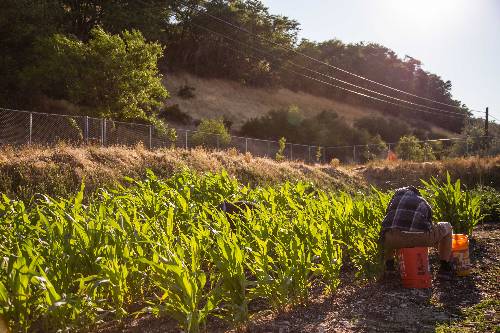Enhance Agricultural Efficiency With High-Quality Water Soluble Polymers
In the realm of modern-day agricultural techniques, the integration of high-grade water-soluble polymers has arised as a promising opportunity to improve efficiency and sustainability. These polymers offer a variety of benefits that can reinvent typical farming techniques, from improving water retention and performance to optimizing dirt structure and nutrient delivery systems. By using the power of ingenious polymer remedies, farmers can potentially open new paths towards attaining higher plant yields while minimizing environmental effects. The application of water-soluble polymers holds the possibility for transformative adjustments in agricultural landscapes, making it a subject worthy of additional expedition in the realm of lasting farming practices.

Advantages of Water-Soluble Polymers
Water-soluble polymers provide a multitude of advantages in agricultural applications because of their enhanced water retention properties and capacity to improve soil framework. Agriculture. These polymers, when contributed to the dirt, can substantially enhance water holding capacity, reducing the frequency of watering needed by plants. By developing a gel-like compound when combined with water, water-soluble polymers create a storage tank that slowly releases moisture to plant origins, ensuring a much more consistent water system throughout droughts
In addition, these polymers help in stopping soil erosion by binding dirt bits with each other, thus boosting soil structure and security. Boosted soil structure permits for better origin penetration and aeration, advertising healthier plant growth and higher plant yields. Water-soluble polymers likewise help in nutrient retention by decreasing leaching, making sure that crucial nutrients continue to be available to plants for a longer duration.
Improved Water Retention and Effectiveness
Enhancing farming water retention and efficiency through the incorporation of sophisticated polymer modern technologies has actually come to be an extremely important focus in modern farming methods. Water-soluble polymers play a critical role in boosting soil structure, enhancing water infiltration, and decreasing water dissipation rates. By forming a thin film on the soil surface, these polymers assist to avoid water drainage and increase the soil's water-holding capacity, ensuring that plants have accessibility to an ample water supply.
Additionally, making use of premium water-soluble polymers can considerably reduce the frequency of watering, as they boost the dirt's capacity to preserve dampness for longer durations. This not only conserves water but additionally lowers the power and labor prices associated with watering techniques. Furthermore, boosted water retention and effectiveness lead to better nutrient uptake by plants, leading to enhanced plant yields and general agricultural productivity.
Boosted Nutrient Delivery Systems
Provided the significant influence of high-quality water-soluble polymers on boosting water retention and efficiency in farming, the emphasis now changes towards optimizing nutrient distribution systems to additionally improve plant development and yield. Enhanced nutrient distribution systems play a crucial duty in making sure that plants obtain the required nutrients in a kind that is readily offered for uptake, promoting their total health and efficiency. By including water-soluble polymers into nutrient distribution systems, the effectiveness of nutrient uptake by plants can be dramatically boosted.
One secret advantage of using high-quality water-soluble polymers in nutrient distribution systems is their capacity to regulate the launch of nutrients, guaranteeing a constant and controlled supply to plants over an extended duration (Agriculture). This controlled release system helps stop nutrient leaching and drainage, thus taking full advantage of nutrient usage by plants and decreasing ecological influence

Dirt Structure Optimization Strategies
Enhancing dirt structure is extremely important in contemporary agriculture for making the most of plant returns and advertising sustainable land administration practices. Dirt structure optimization techniques play an essential duty in making original site sure that dirt gives an optimal environment for plant development. One key method is the enhancement of raw material, such as garden compost or manure, which assists boost soil structure by boosting its water-holding capacity and nutrient retention.
Moreover, exercising minimal husbandry or no-till farming can avoid dirt compaction and promote the advancement of a healthy and balanced dirt framework. Cover cropping is one more reliable strategy that involves planting plants particularly to safeguard and boost the dirt, avoiding erosion and boosting soil structure.
Moreover, executing crop rotation approaches can help break pest and disease cycles, while also improving dirt framework via the differing origin frameworks of different plants. In general, employing these dirt structure optimization methods can result in enhanced agricultural efficiency, minimized environmental impact, and long-term sustainability in farming practices.
Sustainable Solutions for Plant Returns

To attend to the difficulties of maximizing crop yields while advertising lasting land monitoring techniques, discovering lasting remedies becomes necessary in modern-day farming. One lasting option for improving crop returns is the usage of accuracy agriculture techniques.
In addition, advertising crop rotation and cover chopping can help maintain dirt wellness, decrease erosion, and enhance nutrient biking, inevitably adding to higher returns with time. Integrated bug administration techniques also play a key duty in sustainable crop manufacturing by lessening the reliance on chemical pesticides and advertising all-natural insect control approaches.
Furthermore, buying study and technology for establishing drought-resistant crop selections and climate-resilient farming practices can aid minimize the effect of climate adjustment on agriculture while making sure constant yields despite environmental obstacles. By embracing these sustainable solutions, farmers can attain higher plant yields while guarding the health and wellness of the land for future generations.
Conclusion
Finally, using top quality water-soluble polymers in agriculture supplies numerous benefits such as better water retention, enhanced nutrient distribution systems, and optimized dirt structure. By implementing lasting services for plant yields, farmers can substantially increase farming check over here efficiency and efficiency. Agriculture. Water-soluble polymers give a ecologically pleasant and economical method to boost the total performance of farming methods, bring about better outcomes for both farmers and the atmosphere
These polymers supply a range of benefits that can reinvent typical farming methods, from improving water retention and efficiency to optimizing soil structure and nutrient shipment systems.In addition, these polymers aid in stopping soil erosion by binding dirt bits with each other, thereby boosting soil structure and stability. By developing a thin film on the dirt surface, these polymers assist to stop water drainage and raise the dirt's water-holding capacity, ensuring that plants have accessibility to an ample water supply.
Dirt structure optimization techniques play a vital duty in making sure that soil supplies a suitable setting for plant development.In final thought, the use of top notch water-soluble polymers in agriculture offers numerous benefits such as better water retention, boosted nutrient distribution systems, and enhanced dirt structure.
Comments on “The Benefits of Regenerative Agriculture for Soil Health”